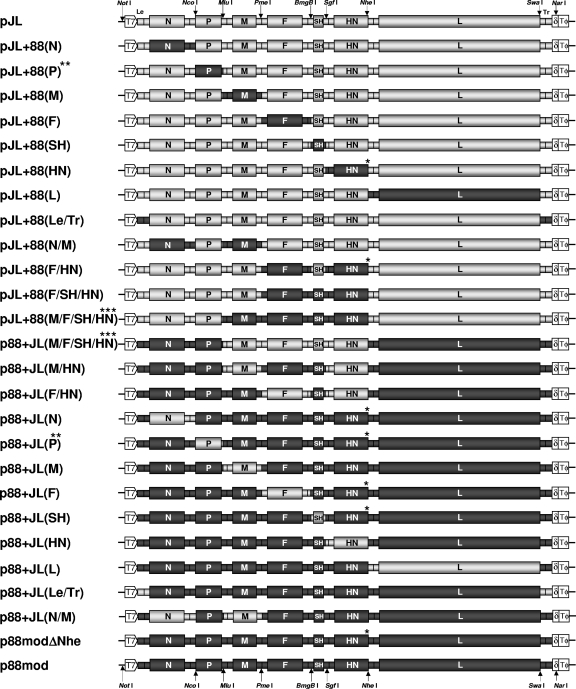Fig. 1.
Overview of the genome structure of chimeric viruses. All chimeric cDNA constructs as well as plasmids p88mod and p88modΔNhe were generated by replacing rJL-specific sequences from plasmid pJL (carrying the antigenome of the major component of the rJL vaccine strain) with those of MuV strain r88. All boxed elements shown in gray or black denote rJL- or r88-derived sequences, respectively. The locations of several restriction sites used for generation of the different constructs are indicated. Note that the NheI site is authentic in the ORF of the rJL HN gene but is not present in that of r88. The NheI site was introduced for cloning purposes in the r88 HN gene and is present in all constructs shown except for those that are marked with a single asterisk. Note that all other restriction sites indicated on the top and bottom of the cartoon are present in all constructs depicted. In all cDNA clones, the antigenome is flanked by a 5′ T7 RNA polymerase promoter and at the 3′ end by the hepatitis delta ribozyme (δ) and the T7 RNA polymerase terminator (TΦ). ORFs are indicated by large boxes. The smaller boxes between ORFs delineate untranslated regions that contain the gene end and gene start signals. The vertical black lines within these smaller boxes indicate the intergenic region. The Le and Tr regions are indicated. Note that the size of the individual genomic elements is for illustration purposes only and may not be to correct scale. Plasmid pJL is identical to pMuV(MPBS) (21). **, note that for reasons of simplicity, the V/P/I gene is referred to here as the P gene, as has been the convention in the past; ***, alternative names are used for pJL+88(M/F/SH/HN) shown in Fig. 2 [p88+JL(Le/N/P/L/Tr)] and for p88+JL(M/F/SH/HN) shown in Fig. 3 [pJL+88(Le/N/P/L/Tr)]. See Materials and Methods for further details.

